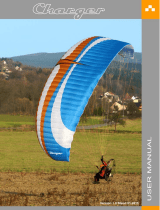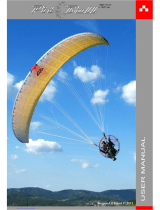Page is loading ...

PARAMOTOR USER MANUAL
ank you for purchasing a PAP machine and trusting in our experience.
is will let you achieve and experience ight in a very simplistic form
and let those childhood dreams of ight become a reality. If you do not
want this dream to become a nightmare then please read and understand
fully the following recommendations about its operation and use.
Enjoy your machine and always respect the ight rules.

ACTIVE SYSTEM ARMS
ATS SYSTEM
1
2
ALL THESE OPTIONS ARE ORIENTATE.
The position can vary depending on the constitution of the pilot. Remembering that this acts as a roman
scale, it is not the same a pilot who is 1.90 m and weighs 95kg, as a pilot who is 1.65m and weighs 95 kg.
Although the recommended angle is 20o regarding the propeller to the ground. Also take
in mind the subjective factor of the flight position, there are pilots who prefer a more upright
position or the contrary.
If the position is too upright you have to pay special attention when releasing the breaks while in flight , as there is a
possibility that they can be aspired by the propeller .
If the position is too inclined forwards, then we will have difficulty getting out of the harness when landing.
The active system arms connect the harness to the frame. Carabiners are located on the harness where the paraglider
risers are attached. The active arm connections points on the active arms work on a scale from A-F.
Before your first flight witf the PAP machine it is necessary to find your ideal static balance when seated in the harness in
the normal flight position, wearing your flight suit and equipment.
This is best achieved by suspending yourself & the machine from a static frame. Moving the attachment points on the
active arms forwards and backwards equally (A, B, C, D, E or F), you can find the optimum tilting angle (20 degrees) off the
propeller to the ground. For lighter pilots move the shackles backwards and for heavier pilot’s move forwards.
The Active Arms System which conect the harness to the frame, where the paraglider risers are attached.These arms have 6
connection points, the function of these points are to have the option to find the ideal static balance when flying together with
the ATS System.
These arms work as a roman scale with it’s different connection points, leaning forwards or backwards in function of the
ATS system. it is necessary to find your ideal static balance, wearing your flight suit and equipment, This is best achieved
by suspending yourself & the machine from a static frame, moving the attachment points on the active arms forwards or
backwards (B,C,D,E,F,) to find the optimum tilting angle 20 degrees of the propellor to the ground. The lighter weight pilots will
move the ATS backwards, and the heavier pilots forwards.
The ATS System is the result of some study work done in the beginning of the Winter of 2012, which had the objective of
improving the engine torque effect. With this system the light and heavy pilots can now fly comfortably with more powerful
engines, and therefore have more thrust. PSince the PAP paraengine units were first made in 1989 they have been
characterized for its low hang point design. Nowadays this is a huge achievement due to the weight of the pilot and the engine
power which is no longer directly proportional. Because of this difficulty many manufacturers who followed our steps with the
low hang point have gone back to the high hang point system to improve the engine torque effect.
ABCDEF
A = +/- 50 Kg.
B = +/- 60 Kg.
C = +/- 70 Kg.
D = +/- 80 Kg.
E = +/- 100 Kg.
F = + 140 kg.
With the ATS System we have achieved without changing the height of the attachment point,
where the the paraglider risers are attached , reducing the anti torque effect and therefore
ensuring a comfortable and precise flight. We could say that the ATS System works as a
stabilizer as the rotation point is about 90mm higher ontop of the arms where the paragliders
risers are attached, just underneath the carabiner of the glider. Preventing with this the
horizontal and vertical movements.
Another advantage of the ATS System is to be able to slide this on the paraengine arm until
finding the exact position for the flight, a approximate angle of 20 degrees from the propeller
to the ground.
B = +/- 55 Kg.
C = +/- 65 Kg.
D = +/- 75 Kg.
E = +/- 85 Kg.
F = + 100 Kg.
REMEMBER THAT NOW THE BALANCING POINT IS THE TOP PART OF THE ATS WHERE
THE PARAGLIDERS ATTACHMENT LOOP GOES THROUGH , SO MOVING THE SHACKLE
HAS NO INFLUENCE IN YOUR POSITION DURING FLIGHT.
SISTEMA ATS

2.1. ATS INSTALATION
1.- Remove the carabiner where the paragliders risers are attached.
2.- Place the ATS on the arm with the regulation screws looking towards the
inside of the harness (fig 01)
.
3.- Pull the paragliders attachment loop through the hole on the top part of
the ATS (fig 02)
.
4.- Put back the carabiner in its position. (fig 03)
.
5.- Pull the arm to its maximum, by pulling the carabiner upwards (fig 04)
.
6.- Sliding the ATS forwards or backwards, seeking the best verticality of the
paraglider attachment Loop (fig05) and (fig06).
7.- Once having done this, fasten the 2 screws on the side (fig07).
(fig
01
)
(fig
04
)(fig
05
)(fig
06
)
(fig
02
)(fig
03
)
(fig
07
)
REMEMBER THAT NOW
THE BALANCING POINT IS
THE TOP PART OF THE ATS
WHERE THE PARAGLIDERS
ATTACHMENT LOOP GOES
THROUGH , SO MOVING
THE SHACKLE HAS NO
INFLUENCE IN YOUR
POSITION DURING FLIGHT.
(fig 05) (fig 06).
/

























